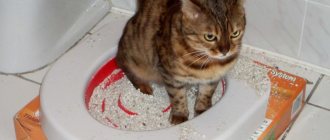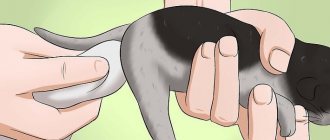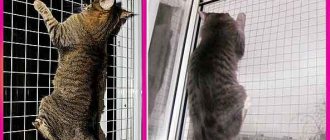How to accustom a kitten to the street
Often kittens are sold already toilet trained. If you live in a private home, you don’t have to buy toiletries for your pet. Indeed, why waste time and money on fillers, trays and other things, if under the windows you have your own courtyard, which can be used as an outdoor toilet and a training ground for walking. Walking will be more beneficial for a cat than constantly walking in a musty room.
First of all, pay attention to your pet's behavior. When he really wants to go to the toilet, the reaction will be determined by searching for a dark corner to relieve himself. At this point, the kitten should be taken out into the yard and wait until it goes to the toilet outside.
He won’t be able to endure it for long: fresh air and pressure on the bladder will take over. This reaction can be repeated day after day. Therefore, you need to react quickly so as not to have to clean up puddles or feces in the house again. So the kitten begins to get used to the fact that there is no litter box in the house and there is nowhere for him to go to the toilet, except outside.
An effective method: walk your cat after eating . Walk regularly and it will give results. Moreover, such walks will benefit both the owner and the pet. The kitten will immediately play out, and then find a favorable place to pee (usually a pile of sand). This is how a reflex is developed and he will automatically learn to go outside after eating in order to successfully do his business.
Domestic cat and street: pros and cons
Should we let domestic cats out for a walk or not? The opinions of their owners on this issue vary. Some argue that the animal is happy to be free at least for a while. Others are convinced that nothing but trouble awaits their pets outside.
Arguments from supporters of the festivities:
- outside the cat will run, climb trees, hunt birds or butterflies;
- in freedom you can meet and “communicate” with your fellow tribesmen;
- on a walk you come across things that are not at home (felines are very inquisitive by nature);
- sun in moderate doses has a beneficial effect on the physical health of the pet;
- no one will scold the animal when it decides to sharpen its claws or mark its territory.
What is against walking is that:
- in nature, a variety of infections lie in wait for a domestic animal;
- in addition to viruses, a pet can pick up parasites (fleas, etc.) on the street, some of which are transmitted to humans;
- when free, it is impossible for a cat to avoid injury (for example, when attacked by wild relatives or dogs);
- our pets don’t know what a car is and can die under the wheels.
Gradually move the tray to the front door
The second method involves purchasing a tray. It is necessary to place the tray closer to the door. If it was in a fixed place, slowly move it towards the exit of the house. Progressively move the pot over short distances. Using its sense of smell, the kitten will find the toilet.
If the kitten constantly resorts to the former location of the litter box and poops on the floor, be patient. Keep a close eye on your cat. Before making a puddle, she can rake in “invisible sand” with her paws. At this moment, pick up the cat and carry it to where the tray is located.
If the process of outdoor toilet training repeats itself endlessly, don't lose hope. The animal will definitely get used to the outdoor toilet. After a few days, your pet will get used to the litter box being outside.
So, the tray has reached the finish line. Now you can safely put it out the door, into the yard. The kitten will look for him, and you will help him by opening the door. The kid will search for the “missing toilet”. He will either find a potty outside or use a hole in the ground as a toilet. The goal will be achieved - the kitten goes outside to the toilet.
During the experiments, the kitten will become so accustomed to the toilet that it will ask to go outside, emitting a pitiful call or scratching the door.
Of course, the yard would be the best option for a restroom:
- Firstly, the cat is in the fresh air, where there are a lot of options for how to relieve yourself.
- Secondly, the pet does not depend on its owners.
- The breeder will not have to wash the litter box.
At what age should you potty train?
Having reached the age of 4-5 weeks, the kitten no longer wants to relieve itself wherever it has to. If he is not trained, he will independently choose a suitable place for himself. Speaking of training, kittens can already master toilet tricks from 6 weeks, and at the age of two months they can cope with this almost perfectly.
If the animal was taken from the street, or came to you at a fairly early age, then you will have to teach it to the toilet yourself.
The older the pet, the more difficult it will be to accustom him to the tray, so you should not delay training.
Many kittens purchased from reputable breeders are already litter box trained.
How to teach a cat to go outside to the toilet?
It seems impossible to train a mature cat to ask to go outside, but even an adult cat can really be adapted to new things in life.
Difficulties do not arise with getting used to the toilet on the street. Many cats are not accustomed to open space from childhood. Accordingly, the animal is afraid of the environment, as it is accustomed to wandering from room to room. You can check for fear in the following way: open the door to the house and observe the reaction.
If the cat does not come out and behaves warily, then the pet is afraid to leave the boundaries of its home habitat. First, walk with her in your arms down the street, and then accustom her to a harness.
To train a cat to relieve itself outside, just sprinkle the usual cat litter on the ground. For those who are picky, you will need to carefully choose a suitable place for the toilet. In some cases, the area should be treated with a special spray.
How to help your cat get used to it
Despite the fact that cats love freedom and independence, life within four walls greatly affects them. Animals living in apartments are likely to be afraid of the street. Loud noises, large numbers of unfamiliar people and other animals, and open spaces are all likely to put your cat under a lot of stress.
© shutterstock
To avoid this, she should be accustomed to the street gradually, step by step.
How to train a kitten to go to the “hole” in a private house?
A common reason why kittens refuse to go to the toilet in a hole in the underground is an inconvenient descent. Or rather, the baby will be able to go down, but it’s difficult to get up. Also, although cats see flawlessly in the dark, young cats are alarmed by the darkness.
Try turning on the light first. If the kitten does not want to go underground, you will have to resort to tricks. Attract his attention with something edible, and then throw the food into the “hole”. He'll definitely come down for some tasty treats.
The descent is easier than the ascent; figure out how your pet can climb back up. You may need to leave some auxiliary items.
Nothing is complicated. It is important to take care of your pet and remember to be patient. After a short period of time, the kitten will get used to going outside.
There are several rules that, if followed, will make the process of toilet training easier.
- When keeping apartments, you must follow the formula: number of cats + 1. If you have one cat, then there should be two trays at the adaptation stage. Purrs are fastidious and if the toilet is dirty, then she can do her business nearby and make it a habit. Feces must be removed after each cat defecation, even if the litter in the litter box is clumping.
- You cannot place a cat litter box in the walkway; the place for the toilet should be private. If the animal is shy, then you can buy a closed tray.
- Do not place bowls for food or drink next to the tray. Cats are squeamish and do not go to the toilet where they eat or drink.
- Plastic trays absorb the smell of urine; according to hygiene rules, they must be changed every six months to a year.
- Changing from one tray filler to another is carried out gradually through partial replacement.
There are no difficulties by breed. But large cats (Maine Coons, Bengals) need a large litter tray. Wood filler and fine mineral filler are not suitable for long-haired breeds. For kittens, a finer litter is usually chosen. By the way, let’s take a separate look at the types of litter for cat litter boxes.
Act calmly and methodically, encourage the kitten
Alluring smells
In order for the kitten to know where its toilet is, it must be guided by smell. You can leave a napkin with the smell of his urine in the tank. This way the baby will understand where his tray is. But after he finishes his job, the tank should be washed thoroughly; felines are very fond of cleanliness.
How to accustom a kitten to the litter box by other means?
Home Remedies
- Mountain lavender. The scent of lavender attracts kittens. A few lavender sachets or plant-scented litter will help with litter box training.
- Cat mint. It has a stupefying effect on the feline - the little one is unlikely to pass by.
Store products
- Ms.Kiss “Litter Tray Accustomed” is a zoohygienic spray that will help accustom a kitten to a litter tray in a certain place. Pros: convenient bottle with ergonomic spray nozzle, good efficiency, low cost. The downside is a rather specific smell.
- Himola “Toilet Training” - bio-spray is designed to develop a strong habit of using the litter box in your kitten. Pros – it sprays easily, attracts the kitten’s attention to the tray. The downside is an unpleasant, persistent smell.
- Api-san “Toilet training” is a smart spray for training a kitten to a litter box or a certain place on the street. It is highly effective, but has a pungent odor.
- Stop Problem “Tray training” – hygiene spray. Designed to correct the kitten's behavior and will help facilitate the process of accustoming the baby to the tray. Pros: pleasant smell and effectiveness. Disadvantage: not suitable for training adult animals.
Causes of cat uncleanliness
- A cat is in heat or a cat is in heat. If an animal does not have breeding value, then it is better to sterilize it. In addition, spayed and neutered cats smell less and stop marking.
- Diseases of the gastrointestinal tract or genitourinary system. In such cases, it is necessary to consult a veterinarian.
- Stress (moving, changing family composition, renovations). Try to keep everything smelling familiar and in its place: beds, food, shelters, water and litter trays. It is also better to consult a doctor; anti-stress vitamins with the addition of medicinal herbs or a spray with pheromones can help.
- Hormonal problems (such as diabetes), joint pain and old age can also cause uncleanliness. The vet is your best friend.
How long will it take to tame
The duration of the taming process depends on the character of the animal and the patience of the owner. It is different for everyone, so it is impossible to give an exact answer - for some the process will take a month, and for others even a year will not be enough. If you do everything correctly and calmly, the result will not be long in coming.
If the cat does not go into your arms, but he is calm, has a good appetite, and there is no reason to worry, then it is better to leave him alone.
Important! There is no need to try to forcibly accustom the animal to contact, this will only make him angry. Knowing how to tame a kitten in your hands, it is easy to achieve the desired effect
If you follow the necessary rules and have patience, you can achieve the desired results in a fairly short time. It is recommended to remember that not all breeds are prone to constant contact with humans, so you should not try to pick up the animal by force
Knowing how to tame a kitten in your hands, it is easy to achieve the desired effect. If you follow the necessary rules and have patience, you can achieve the desired results in a fairly short time. It is recommended to remember that not all breeds are prone to constant contact with humans, so you should not try to pick up the animal by force.
Types of cat litter, their pros and cons
1. The absorbent filler can be mineral (contains zeolite), wood (granulated sawdust) and silica gel. It is customary to completely replace the absorbent filler approximately once every 5-7 days.
Mineral or zeolite filler
Sometimes it is large and is not very popular with cats that have sensitive paw pads.
Wood filler
Ideal if there are other animals in the house. The dog may become interested in the contents of the tray. If she eats a wood filler pellet, it won't do much harm. If there is a rodent or rabbit in the house, then wood filler can be poured into the tray of the cage. Wood fillers are also suitable for them. But the wood filler generates dust, small sawdust spreads throughout the apartment. In long-haired cats, this litter may remain on the panties (feathers of the hind legs) and tail.
Silica gel filler
Does not generate dust and is very economical. Ideal if the cat owner is allergic. The standard package is enough for one month for one cat. But you need to get used to it, as it crunches under your paws and can frighten the animal.
2. Clumping filler can be bentonite (clay), wood or combined. When urine or feces gets into the tray, the filler forms a hard lump, which can be removed with a scoop and the dry filler can be added as needed.
Bentonite filler
Doesn't hold odor very well and can get dirty on your cat's paws, and may even leave marks on the floor.
Wood clumping filler
The good thing is that small lumps can be flushed down the drain. The only negative is the high cost, since it is not produced in Russia.
Mixed filler
Quite good for the price and quality.
You can put napkins or toilet paper in the tray. Some cats go to the litter box without litter. In this case, it is more difficult to monitor the hygiene of the cat litter box, because it will have to be washed daily. Sometimes cats are taught to relieve themselves in the toilet; there are special devices for this.
Choose a filler depending on the breed and your capabilities
Checklist - 11 tips
For convenience, we offer you a checklist “How to train a kitten to use a litter box.”
No1. Restrict access to all rooms at once. -The kitten may get lost or, having played too much, will not have time to reach the tray.
No2. Buy the same type of litter that the kitten is used to using from previous owners. -Find out what type of litter (wood, silica gel, mineral) the kitten used before, buy a litter of the same type. -Over time, you will be able to switch to another type that is more convenient for you.
No3. Add some used litter to the tray. -Ask the previous owner for some of the “described” filler, pour it along with the clean one. -At first, when cleaning, you can leave a little “wet” litter so that the smell reminds the kitten that this is his toilet.
No4. Show that you can dig in the filler. -After placing the baby in the tray, dig a hole with your finger so that the kitten can see it. -Do not try to teach digging by holding the paws.
No5. Place in the tray more often. -How to quickly train a kitten to use the litter tray? Sit him in the toilet more often after eating, sleeping, and active games. -If you notice that it is “pasting” in the wrong place, carefully move it to the toilet.
No6. Don't punish for puddles. -Remove the puddle and treat the area with a special product.
No7. Place the tray in the place where the kitten frequents. -From the beginning, it is important to teach the kitten to go to the litter box. -Later you can rearrange it where it is convenient for you, gradually moving it.
No8. Place the food bowl in an undesirable place for the toilet. -Usually cats don’t shit where they eat and drink.
No9. There should be a toilet on each floor if the house has several floors.
No10. One cat may need two litter boxes. -Some people like to do “wet” things in one, and “serious” things in another :-)
No11. Each cat has its own litter box! -Many cats do not like to share their litter box with others. -If possible, place containers for different cats in different places.
To toilet train an adult cat, use the same algorithm.
Get to know interesting cat breeds with the help of our encyclopedia: Bengal, Cymric, British Longhair.
How to choose a place for a house
Each breed has its own preferences. The issue will be discussed in more detail in Table 1. But there are general requirements for the location of a new home; they must be taken into account first of all:
- absence of drafts;
- location near heating devices;
- location of the home near a computer, TV and other objects that emit radiation.
Table 1. Cat breed and preferred location of the cat house.
| Cat breed | Preferred location of the house |
| Siamese | Loves to be in the center of attention and events, carries a pronounced hunting instinct. It is advisable to place the house in the corridor so that the animal has an overview of all rooms and premises. Noise and constant walking near the home will not disturb the pet, but, on the contrary, will create the most comfortable conditions for it. |
| Scottish and British | These breeds love comfort and security. Cats with a calm and domestic character. It is advisable to place their home away from the hustle and bustle in a secluded place; a corner of the bedroom or in the living room between the wall and the sofa is suitable. Try to create as private an environment as possible to create comfort and a sense of security for your cat. |
| Persian | These cats are true owners and sincerely consider themselves the head of the family. Where all family members most often gather, place a new home for your pet there. He will feel as comfortable as possible among his family and will quickly get used to the house. |
| Sphinx | These animals love to be around people. They will accept a new home if it is in the master bedroom and has more warm and cozy bedding. |
| "Dvorovaya" | For simple cats, in which the hunting instinct is alive and active, a high location of the house above the floor and a good view of the housing will be preferable. These animals are solitary by nature; place the house in the room where the least amount of people gather. |
At the first stage of training, do not place the house in the place of the cat’s former bedding, to which she is accustomed. Instead of acceptance, it can cause rejection. Place the dwelling close to the litter and begin to actively accustom the animal to it.
How to protect your cat from hairballs in her stomach when shedding?
Types of models
Today on the pet supply market you can find a huge variety of furniture for animals. This also applies to cat beds. They can be classified by color, material, shape and size. Since cats spend a considerable amount of time enjoying sleep, a bed for your beloved cat is a special item.
You need to choose it wisely, so first of all pay attention to their main varieties:
- Basket. A bed of this type can be made from wicker using the weaving method or from its analogues, including plastic. The advantage of such models is their appearance. Additionally, the bottom is lined with soft bedding or pillow. Among the disadvantages, it should be noted the difficulty of cleaning and the love of cats to sharpen their teeth and claws on the bars of the basket;
- Bagel. This is a soft analogue of a basket. It has the appearance of a volumetric litter. Inside, the fabric is thinner, and the edges are surrounded by a dense roller, which serves as a kind of limiter;
- Hammock. This is a hanging model that can be placed at almost any height. It is especially popular to hang it near batteries in winter. The cat gets the opportunity to take a high-altitude position, which some animals especially like. Difficulties may arise when using it with small kittens, injured, sick or simply old animals;
- Little house. This is a closed option that allows the cat to feel in complete privacy. It can be much more difficult to accustom an animal to a house than to a simple bedding. They can be soft, tension, with hard walls, multi-level, etc.
In addition, in order to quickly accustom an animal to a bed, it is important to pay attention to some other parameters:
Heat
Feeling warm is very important for pets, especially cats. They love to sleep in radiators, and therefore you can retrain them to use the house only if it is warm enough in it, and the temperature is maintained at the optimal level for a long time; Convenience
A basket or a closed hut - the choice is mainly up to the pet. In any case, the lounger should be suitable in size and not cause discomfort. Consider additional use of soft bedding if necessary; Care. This question is especially relevant for owners of representatives of fluffy long-haired breeds. Houses and wicker baskets are quite difficult to remove wool from, unlike hammocks and bagels. Machine washability is a clear advantage. It is also important to provide for the possibility of sanitization in case of infestation by parasites.
Do you want to accustom your cat to a bed? This means that the animal needs to like the house. Unfortunately, it is very difficult to determine this in advance, so you need to know some tricks and tricks.
Tidbit or gingerbread method
Education is an entertaining process, especially when there is a return.
So, this same return can be obtained twice as fast if you use incentives for each successfully completed task. This could be a favorite treat: a piece of sausage, a piece of chocolate, the main thing is that the kitten really wants it at a specific period of time. By the way, you can always carry a tasty morsel with you, in the pocket of your robe or trousers, and start training with your pet at any time when there is an opportunity and the “student” is in a favorable mood.
As soon as the animal appears in the field of view, they beckon it to you with their fingers, while pronouncing the invented name out loud (by the way, all household members of the kitten should call it the same so that the poor thing does not get confused)
When the baby deigns to pay attention to the owner and comes up, he is treated to a “delicacy”, gently scratched behind the ear or patted on the back, continuing to click on the name
Over time, it will be enough to simply call the baby so that he runs up to his beloved owner. It is not forbidden to give treats from time to time, otherwise the conditioned reflex will fade away as quickly as it appeared: they say that I will run to you if you cannot offer anything.
Suitable filler
Many owners skip this important step. But the more correctly the filler is selected, the faster your ward will remember where his toilet is. A natural and safe filler is suitable as a filler: sand, but it requires constant replacement. Granular litters are a good idea. Some manufacturers even offer special fillers - when urine gets into them, they form into a dense lump. It is simply taken out and thrown away.
- Some kittens try to eat litter, so to be safe, choose natural and safe litter.
- It is not recommended to buy brands with fragrances and fillers with antibacterial properties; most of them contain chemicals that are toxic to babies.
- It is also worth abandoning clumping fillers. They are only suitable for adult cats, but for babies this is a serious danger; kittens can swallow the lump.
Litters containing wood and corn pellets are excellent for litter box training. You should not change the litter until the kitten is used to the toilet.
How to choose a harness
The design consists of a pair of rings connected in the back and chest areas.
Certain points that you should definitely pay attention to:
If, when stretched, the cat begins to breathe loudly and wheezing appears, it is strictly forbidden to use such a device. Another important condition for comfortable use of the harness is soft but durable materials. During a walk, a cat may accidentally get into the mud, so washing will also become a regular procedure for caring for the accessory. The width of the straps should not exceed 1.5 cm
Wider ones will interfere with the movement of the animal, and narrow ones will lead to chafing of the skin. The fastening parts must be securely fixed. The overall service life of the product will depend on their quality.
Reflective models. Today it is possible to purchase harnesses made of reflective materials. You need to think about this issue if there is active traffic in the area of future walks. Cats rarely recover completely after being hit by wheels. Most often the result is sad.
Fit. The size must be adjusted so that the connecting parts of the belts are located in the area where the shoulder blades converge and the beginning of the sternum. These areas are easily determined by simply feeling the animal's body. The most important thing is that the belts should not touch the neck.
Product materials. The materials from which the harness is made are also important. For small kittens, you can buy elastic accessories. These are not suitable for adults. Cats are extremely fidgety, so they can easily get rid of a fixed composition.
These rules are most important when choosing harnesses for short-haired cats. Pets with thick and long fur are more protected from possible squeezing











